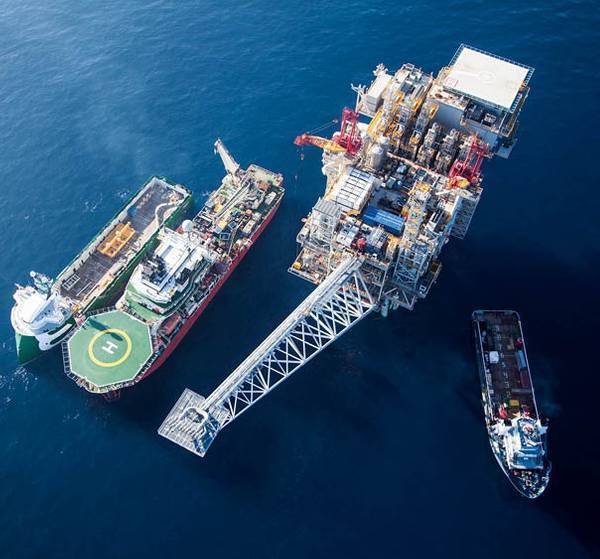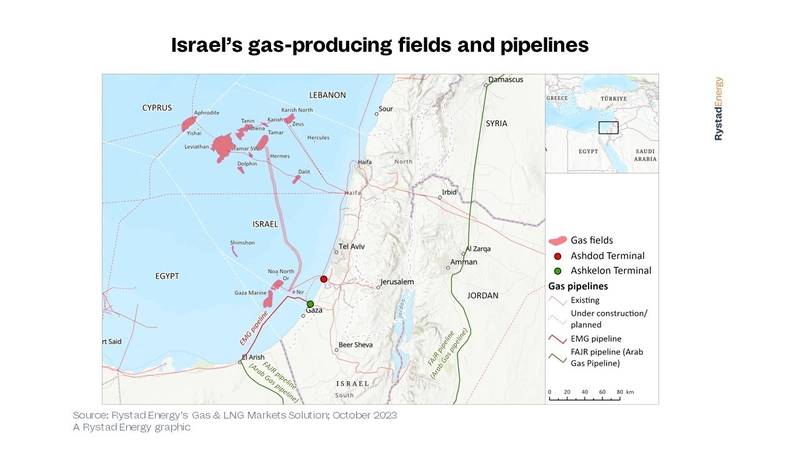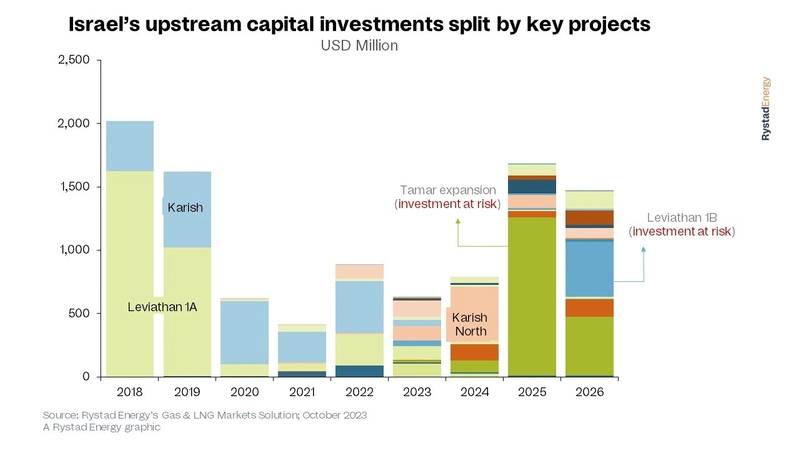
The ongoing conflict between Israel and Hamas, the Palestinian militant group, poses a serious threat to the regional natural gas market and could have knock-on effects on Europe’s liquefied natural gas (LNG) supply as winter approaches, Rystad Energy, a Norway-based energy industry intelligence group said Thursday.
"Although Israel has surplus gas production, which currently supports Egypt and Jordan’s growing demand, a continued or escalated conflict would have wide-ranging implications," Rystad said.
According to Rystad, the fate of the three largest Israeli offshore gas development projects – Tamar, Leviathan and Karish – will affect the regional market greatly, and a regional geopolitical reshuffle could hold up normalization progress, risk upstream investments, and spoil export goals at a time when exploration and discovery of low-cost resources have increased.
"Leviathan represents 44% of Israel’s current gas production, followed by Tamar and Karish with 38% and 18%, respectively. Tamar supplies more than 70% of Israel's domestic gas demand and is the primary source of gas-fired electricity generation. It is estimated that 5% to 8% of Tamar's production is exported," Rystad said. Worth noting, Chevron was ordered to shut down production at the Tamar field.
Egypt imports about 7 billion cubic feet per year of natural gas from the Tamar and Leviathan developments, helping meet domestic demand and power liquefaction plants.
Rystad Energy accounts that Egypt exported 3.7 million tonnes of LNG between October 2022 and January 2023, with the highest amount being just less than 1 million tonnes in December 2022. This peak production is roughly equal to Tamar's 33-day production shutdown at current rates.
According to Rystad Energy, Israeli gas currently meets less than 10% of Egypt's gas consumption and, in the first three quarters of this year, exports of LNG fell by about 50% compared to last year. This decline resulted from an increase in domestic gas usage during the summer season. Given these evolving dynamics, questions arise about the sustainability of gas exports to Egypt as winter approaches, Rystad said.
Aditya Saraswat, Vice President Middle East Upstream Research at Rystad Energy: "Despite the bleak forecast for the upcoming El Niño winter, the current situation presents a bullish factor. European Union (EU) storage currently stands above 97% and gas consumption is still below levels registered in 2022. Furthermore, there is a possibility of increased gas exports from the US.
"The ongoing conflict is likely to have a limited upward impact on near-term gas prices that will reflect a geopolitical risk premium already manifested in oil prices. However, there remains a risk of escalation into a broader conflict that could cause a short-term increase in energy prices. If high energy prices lead to inflation and further interest rate tightening, they may eventually correct down in the months ahead if the economic outlook worsens on this account,”  Credit: Rystad
Credit: Rystad
The Tamar gas reservoir rapidly developed over a period of four years as a response to Egypt's cessation of natural gas supplies to Israel.
Tamar normally operates six production wells, with a daily output ranging between 7.1 million and 8.5 million cubic meters per day (MMcmd) of gas. The project has played a significant role in boosting Israel's energy independence, fulfilling 70% of its electricity generation needs and decreasing its dependence on coal and oil.
If the Tamar gas field has a short shutdown, Israel will use other fuels like coal and fuel oil to generate electricity. However, prolonged shutdowns may require drilling additional wells, which could take months and Israel will be forced to use gas from the Leviathan field to meet its own needs instead of selling it to nearby countries like Jordan and Egypt, Rystad said.
Jordan gets most of its gas imports from the Leviathan field -located near Tamar, which is also the main source of gas exports to Egypt. If the conflict gets worse, there is a risk of shutting down the Leviathan field. This would be a significant setback for the region, given that Egypt has been importing almost double the contracted volumes of gas from Israel recently, Rystad said. In 2022, Leviathan exported 4.9 billion cubic meters of gas to Egypt, compared to 3.1 billion cubic meters in the first half of 2023.
In addition, Rystad said, there is a considerable risk of losing around $4 billion in capital investments for important upstream projects during the next three years due to the potential shift in the regional landscape. This turn could undermine the progress made towards normalizing a region that has seen significant exploratory success and the discovery of low-cost resources.
In 2025, the Tamar expansion project will be the most heavily impacted out of all the upstream projects in Israel. Out of the $1.6 billion expected to be invested in these projects, 75% - equivalent to $1.2 billion - is designated for the expansion of the Tamar natural gas reservoir, Rystad added.
Also, Rystad says that Leviathan Phase 1B is another plan impacted, particularly in 2026, as $435 million of capital investment is at risk.
The goal for Leviathan is to set up a Floating Liquefied Natural Gas (FLNG) unit with a capacity of 4 to 5 million metric tonnes per annum (MMtpa) as an alternative to tapping into the European market. The Leviathan field can produce up to 2.1 billion cubic feet per day (Bcfd) and its ramp-up potential is about 700 million cubic feet per day (MMcfd).
Also, Rystad highlighted that Israel, Egypt and Cyprus are working to build the Eastern Mediterranean pipeline that will transport natural gas to Europe via Greece.
"The estimated cost of the project is $6.5 billion and it faces challenges due to border disputes in the region. The project could be profitable due to the low cost and ample supply of natural gas and its capacity could be increased from 10 to 20 billion cubic meters per year. However, investors may be discouraged from investing in the project due to its high cost and conflicts," Rystad said.
 Credit: Rystad Energy
Credit: Rystad Energy